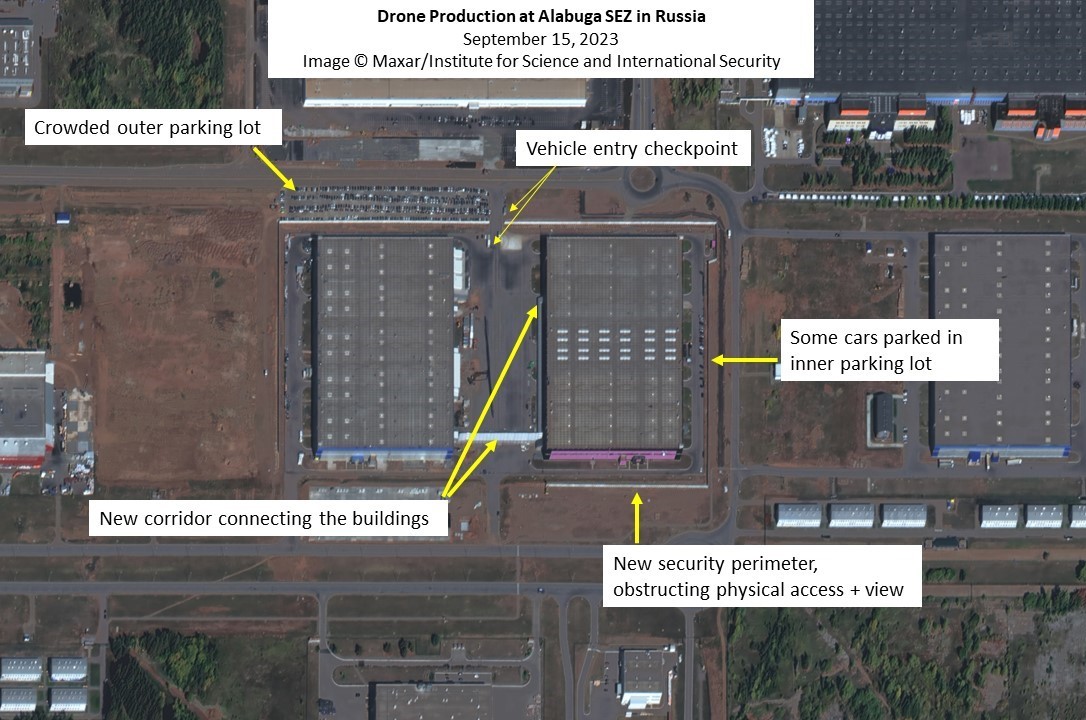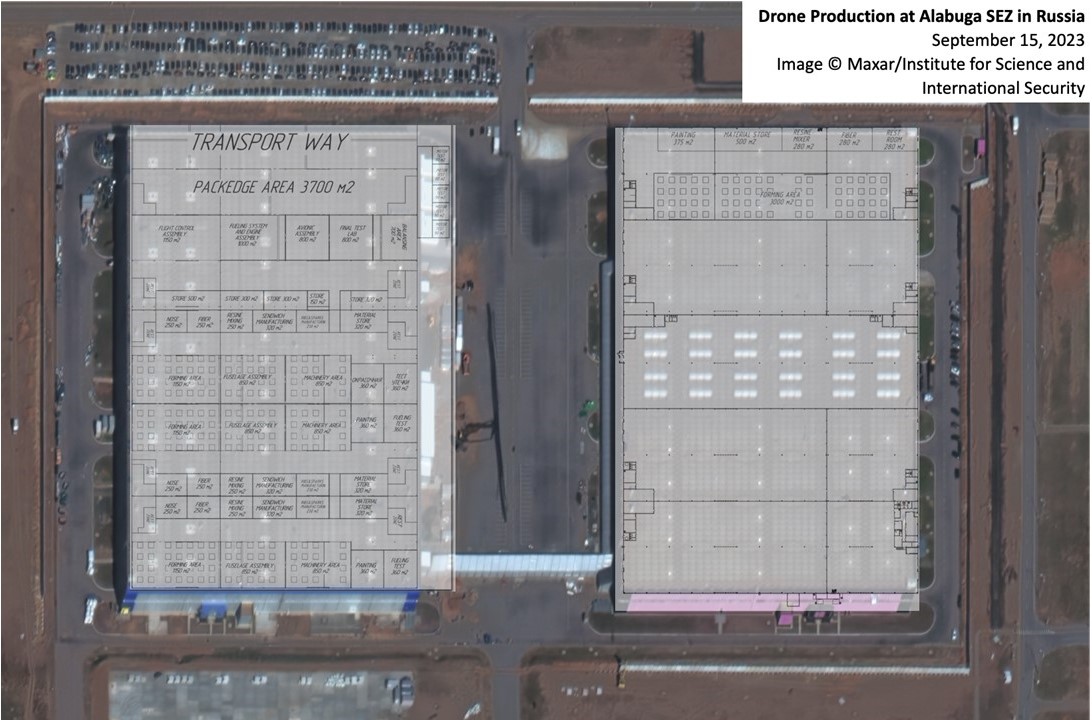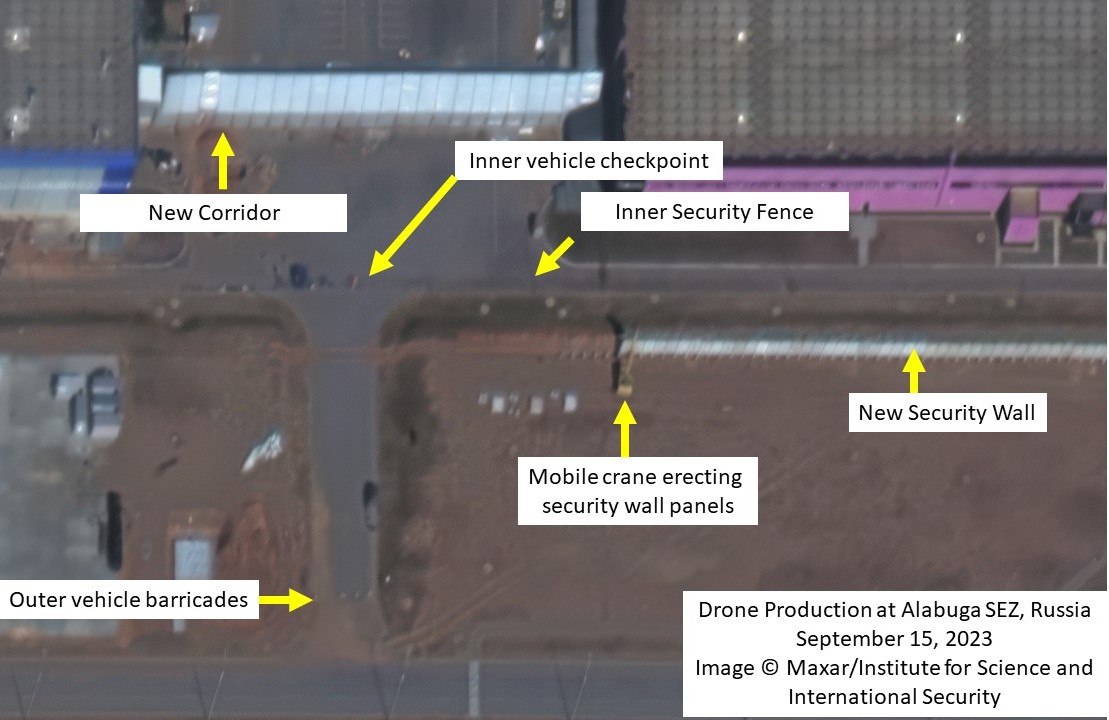Reports
Visible Progress at Russia’s Shahed Drone Production Site Satellite Imagery Update and Call for Action
by David Albright, Sarah Burkhard, and the Good ISIS team
November 13, 2023
Nearly three months after the Institute and The Washington Post publicly revealed detailed information on the plans of JSC Alabuga 1 (“Alabuga”) to produce thousands of deadly Shahed-136 kamikaze drones on Russian soil, satellite imagery indicates that plans are progressing at the Alabuga Special Economic Zone. Yet, the company responsible, JSC Alabuga, and related companies are still not found on public U.S. or allied sanctions lists. The information in internal documents, analyzed by Institute staff over hundreds of hours, reveals not only detailed timelines for Alabuga’s production of weaponized drones and the establishment of mass production with Iranian assistance, but also multiple pressure points and vulnerabilities. Now, not later, is the time for the U.S. government to take the lead, work with partner governments and industry, and use leverage against those less inclined to cooperate, to hinder Alabuga from succeeding in providing the Russian military with thousands of Shahed-136 drones. With winter fast approaching, and Alabuga’s Shahed output increasing, Russia can be expected to accelerate its Shahed-136 attacks against Ukraine’s vital energy infrastructure, causing brutal living conditions for the civilian population. A key, overdue first step is for the United States and its allies to sanction JSC Alabuga and its associated companies.
The Main Production Site at Alabuga
A September 15, 2023, satellite image shows the two main fabrication buildings in the Alabuga SEZ in Yelabuga, Russia, where Shahed-136, aka Geran-2, production takes place (see Figure 1). The buildings were identified by the White House as involved in Shahed drone production early this year, and the internal Alabuga documents confirm the location and reveal JSC Alabuga as the main responsible party for the production and supply of drones to the Russian military. Alabuga numbered the buildings in order of construction, 8.1 and 8.2, where 8.1 is east of 8.2. The internal Alabuga documents contain a floor plan for each of the two buildings that precisely match the size and configuration of the buildings (see Figure 2). The floor plan for building 8.2 focuses on Shahed production and is more detailed, while the floor plan for building 8.1 is less detailed. This can be explained by additional documents containing information on additional drone types to be produced in building 8.1. The satellite image dated to mid-September shows construction that directly correlates with the planned layout of building 8.2, indicating that Alabuga is making progress in executing its production plans, which includes not only adopting Iranian production processes but improving and streamlining them, and ultimately advancing the drone’s capabilities. The image also shows that Alabuga is completing new security perimeters, including a large wall with checkpoints at what was a historically civilian commercial site. Further, on the latest imagery, the employee parking lot in the northwest corner of the facility was full with about 350 vehicles visible just outside the perimeter wall, and more than a dozen higher-ranking personnel vehicles present inside the wall along the eastern side of Building 8.1.
Changes at the Site Since April 2023
Since the White House released an image of the buildings taken in April 2023, new construction includes an addition to building 8.2 that directly matches the layout of a series of five motor test cells (see Figure 3). The addition measures about 20 meters by 55 meters, consistent with five motor test cells about 9.5 meters long. The cells are set up in two pairs and one single one, apparently with matching equivalent ventilation units (grey colored rectangular stack structures on the right).

Figure 1. Recent changes around the two main buildings where Shahed-136 production is taking place. Building 8.2 (left) and 8.1 (right).

Figure 2. Overlay of floor plans for building 8.2 (left) and 8.1 (right) from internal Alabuga documents on recent satellite imagery shows that the buildings’ dimensions and features match the layouts precisely.
Figure 3. The addition to building 8.2 appeared after April 2023 and matches the dimensions of five motor test cells for Shahed-136 production included in the building layout.
Changes at the Site Since July 2023
Notable is a newly built corridor that connects the two buildings 8.1 and 8.2. Most interestingly, the corridor does not connect the two buildings in the middle, but rather it leads from the southern third of building 8.2 to the southern third of building 8.1, and then up along the west side of building 8.1 to the top third of that building. Based on the floor plans of the buildings, at least the top fifth of the floor space in building 8.1 is dedicated to Shahed production.
Alabuga is also installing physical security perimeters around buildings 8.1 and 8.2, where an outer security wall is being erected in addition to a previously built inner security fence. This is one of few sites within the Alabuga SEZ with such visible security measures, consistent with the fact that the drone production contract for the Russian military represented a major shift in Alabuga’s business strategy, aimed at attracting international producers of a variety of civilian goods before the war. Figure 4 shows the inner security fence and a mobile crane erecting concrete panels for the new outer security wall. Construction of the wall began before July 25, 2023, but is largely finished as of mid-September. Security checkpoints and road blockades are visible at the north and south entrances. A later, lower resolution mid-October image (not presented here) shows the wall to now be complete.
Figure 4. Alabuga recently erected physical security measures around buildings 8.1 and 8.2. A new outer wall was near completion in mid-September.
Timeline of Shahed production at Alabuga
Ongoing construction around 8.1 and 8.2 is consistent with the main timeline revealed in internal documents, namely that Alabuga was to begin with onsite assembly of drones provided by Iran in the first months of 2023 while transitioning to onsite airframe production. In the second half of 2023, Alabuga was to establish production lines for internal components onsite. According to these internal plans, beginning in 2024, Alabuga is expected to be able to make additional major components, including internal components, such as navigation, anti-jamming and anti-spoofing modules, engine, and propeller, onsite. At this point, monthly production of drones would increase to up to 226 drones per month, for a total of 6000 drones produced by September 2025. Figure 5 shows the timeline of Alabuga’s planned production and the total number of drones supplied to the Russian military since early 2023. By the end of October 2023, factoring a one month delay that became apparent as a minimum delay in overall plans, Alabuga planned to have supplied 1400 Shahed-136 drones to the Russian military for use in Ukraine.

Figure 5. Cumulative number of Shahed 136/Geran 2 drones slated for delivery by Alabuga under its contract with Russia’s Ministry of Defense. Each month represents the end of the month.
1. JSC SEZ PPT Alabuga is a joint stock company where shareholders are 100 percent state-owned, with 66 percent Russian state and 34 percent Republic of Tatarstan. It controls the management company of the Alabuga Special Economic Zone and operates the Limited Liability company Alabuga Development, which builds the infrastructure but also engages in procurements for the site, including the drone projects. There are also related companies that engage in foreign procurements. The SEZ comprises 40 square kilometers in the Yelabuzhsky District of the Republic of Tatarstan, ten kilometers from Yelabuga. ↩



 twitter
twitter